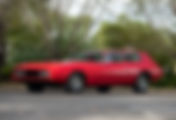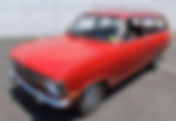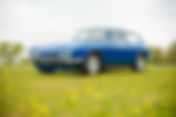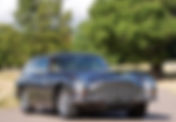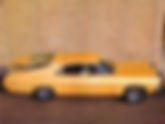Search Results
2341 results found with an empty search
- 1970 Porsche 914 by Eurostyle
Built with the collaboration of Volkswagen - it was only just for sale when Carrozzeria Eurostyle of Turin unveiled their coachbuilder's view on the car at the Turin Motor Show of 1970. The Eurostyle-Porsche was designed by Albrecht von Goertz (who had also designed the BMW 507) and was somewhat revolutionary in style and function. The shooting brake-style rear of the car is fitted with doors that open to the sides, a bit similar to the Ferrari Daytona shooting brake built by Panther, but this time electronically-controlled too! The front could be tilted forwards to gain easy access. No more than two cars were built in Turin. View the World's Largest Shooting Brake Archive Here (Sources Included)
- 1970 Cadillac Eldorado Station Wagon by George Barris
In Barris's "Barris: Kustoms of the 1960s," co-written with David Fetherston, George Barris claims this car idea originated when he pitched a 1970 Eldorado station wagon concept to Dean Martin and came up with the Casa de Eldorado. View the World's Largest Shooting Brake Archive Here (Sources Included)
- 1969-1970 Murena 429 GT by Intermeccanica
The Intermeccanica Murena resulted from a brief foray into the world of car making by two Americans, M. Charles Schwendler and Jospeh Vos. The two men planned to build the fastest and most luxurious station wagon (shooting brake in Europe) that the world had ever seen with styling that no one would ever forget. They succeeded on all three points. However, the unique styling wasn’t well-received in 1969, and the doubled price tag of a new Porsche 911 resulted in very slow sales. By the time the company folded in 1970, just ten had been sold. The Murena was taken care of by Intermeccanica in Italy; each body was individually coach, built from steel by Italian specialists, and given an American powertrain – specifically the 429 cu. in. (7 litre) V8 from the Ford Thunderbird and the accompanying 3-speed automatic transmission. This engine turns out 360 bhp at 4,600 rpm 480 ft-lbs of torque at 2,800 rpm, the vehicle's weight is 3770 lbs, the 0-62 mph time is 7.5 seconds, and the 1/4 mile time is 15.5 seconds. These were respectable times for a luxurious four-seater with ample luggage space and air-conditioning in 1969. View the World's Largest Shooting Brake Archive Here (Sources Included)
- 1968 Opel Kadett L Shooting Brake
This 1968 Opel Kadett L 2-door station wagon, also known as a shooting brake, has undergone a detailed restoration and is a multiple award winner, having taken home many first places, best in the show, and people's choice awards from various car shows. The Kadett is powered by a rebuilt 1.1 liter overhead valve 4-cylinder water-cooled engine with twin Solex 35 PDSI carburetors and is mated to a 4-speed manual transmission. Making 55-horsepower, the engine has been fully detailed and runs excellently. The odometer on the Kadett B shows 84,531 miles, which is believed to be original according to a running log supplied with the car. However, given the restoration completed on the Kadett, it feels almost like a new car. The interior of the Kadett features a redone headliner and new carpet, while the seat upholstery appears to be original and is in excellent shape. The original Kadett Delco AM radio is present and works, while under the dash, a vintage Audiovox FM converter allows listeners to tune in to their favorite modern radio stations. Additionally, the Kadett has all of its original German Sekurit glass, and under the hood, it retains all the proper German parts from Bosch, Solex, SWF, and ATE. View the World's Largest Shooting Brake Archive Here (Sources Included)
- 1968 Fiat Dino Ginevra
The Dino Ginevra was designed in 1968 by Pininfarina. It was a design development of the Fiat Dino from the previous year and explored the idea of the sports coupé. It featured a front-mounted engine from the Ferrari Dino. View the World's Largest Shooting Brake Archive Here (Sources Included)
- 1968 Fiat 125 Station Wagon by Savio
The Turin Motorshow of 1967 saw Savio displaying a 2+2 coupe based on the 125. One year later, Savio constructed a type of sporting estate or hatchback on the same mechanicals at the same show. View the World's Largest Shooting Brake Archive Here (Sources Included)
- 1968 Jaguar XK150 Estate
The famous Jaguar XK 150 Estate started life as an RHD 3.8 Coupe. It was upgraded to the "S" specification in 1963. British race protagonist Douglas Hull then bought the Jaguar. In 1968 "Peels of Kingston" coachbuilders were commissioned to design and built an Estate car. The car was used to tow Patrick Lindsey's ERA single-seater to various race events. View the World's Largest Shooting Brake Archive Here (Sources Included)
- 1968 Chevrolet Corvette Stingray Shooting Brake
Its owner sold this customized shooting brake Corvette on eBay in 2007. Where is it now? View the World's Largest Shooting Brake Archive Here (Sources Included)
- 1968-1975 Reliant Scimitar (SE5/ 5A)
The Scimitar GTE came in 1968 as the SE5 was born with a more extended all-new chassis and revised and improved suspension. This new Scimitar was constructed as a sporting estate car and proved highly successful. Designed by Ogle’s Tom Karen, the SE5 was powered by a Ford 3.0 liter V6 engine, so performance was good with close to 140 bhp under the bonnet, and the body styling was so well received other manufacturers raced to produce their versions such as Volvo’s P1800ES and Lancia’s Beta HPE. The GTE SE5 was an instant success for Reliant, with production increasing by 20% in the first year, power and performance continued to improve over the next two years, and in 1972 the SE5A was introduced with performance statistics being much better with a top speed of over 120 mph and 0-60mph times a staggering 8.5 seconds. View the World's Largest Shooting Brake Archive Here (Sources Included) 1970 Reliant Scimitar GTE 1972 Reliant Scimitar GTE 1974 Reliant Scimitar GTE
- 1967 Fiat Dino Parigi by Pininfarina
This was an aerodynamic study based on the Dino. At the Paris Motor Show in October 1967, Pininfarina presented the Fiat Dino Parigi. It used the engine (2000) of the production cars, while the wheelbase (2290mm) was slightly longer than the production Spider. View the World's Largest Shooting Brake Archive Here (Sources Included)
- 1967 Ferrari 330 GT 2+2 'Navarro' Drogo
Navarro's car is known by a series of names, including the "Golden Car," both for its paint and its side logo; the "Ferrari 330 GT 2+2 Speciale," perhaps the car's most generic name; and the "Navarro Special NART," for its later association with American Ferrari importer Luigi Chinetti. Though the body may differ radically from a stock 1966 Ferrari 330 GT 2+2, the two cars are virtually identical under the skin. Power comes from a 4.0-liter V-12, rated at 300 horsepower and mated to a five-speed manual transmission. The layout was a front-engine, rear-drive, and a live axle was used in the rear instead of a fully independent suspension. Disc brakes were fitted to all four corners, ensuring that 330 models could scrub off speed as quickly as they could generate it. The body of the 1966 Ferrari 330 GT Navarro Special has generated more than a bit of controversy over the years, with some questioning why Piero Drogo's shop, Carrozzeria Sports Cars, would even undertake such a project. Drogo died in a 1973 car accident, so his ultimate motivation is lost to history, but it likely comes down to this: As a small coachbuilder, it's never wise to turn away business. Drogo's firm had experience creating new bodies for other Ferrari models, the most renowned of which is likely the 1962 Ferrari 250 GT "Breadvan," designed by Bizzarini but built by Drogo. View the World's Largest Shooting Brake Archive Here (Sources Included)
- 1967 Aston Martin DB6 Shooting Brake by FLM Panelcraft
Innes Ireland was a hugely successful F1 driver who also won the Tourist Trophy driving a Ferrari 250 GTO and campaigned several marques during his international racing career, including Lotus and Cobras, and having great success in GT40s and, of course, the Aston Martin DB4GT and project cars. This Aston Martin DB6 Vantage, chassis number DB6/3310/R, was bought new by Innes Ireland in 1967. In 1969, Ireland took the car to coachbuilders FLM Panelcraft in London to be converted into only two shooting brakes they produced on the DB6 chassis. Innes Ireland was the president of the British Racing Driver’s Club until he died in 1993. View the World's Largest Shooting Brake Archive Here (Sources Included)
- 1966 Mercedes-Benz 230 SLX Shooting Brake by Frua
In 1966, the Turin coachbuilder Pietro Frua, a prominent car designer in Italy in the 1960s, presented a coach built 230 SLX Shooting Brake inspired from the 2-seater Mercedes-Benz 230 SL Pagoda Roadster. View the World's Largest Shooting Brake Archive Here (Sources Included)
- 1966 Lamborghini 400GT Flying Star II
At the 1966 Turin Auto Show, Touring displayed their latest car, the Flying Star II; this was the last car completed by this prestigious firm whose contributions to car design in the previous 40 years can’t surely be forgotten. Touring designed and built the Lamborghini 350GT (see entry), the company was founded by Felice Bianchi Anderloni in 1926, but in 1966 it all came to an end, on that year’s Turin Auto Show, they prepared two new cars; a Fiat 124 convertible, and the Flying Star II, which, just like the 3500 GTZ, was mounted on a 10 cm shortened chassis. The Flying Star II was created by a team led by Carlo Anderloni, son of the founder; the results of this Lamborghini were somewhat disappointing; the angular lines of the body, together with the controversial roof design, made the car look like a station wagon, it also was massive for only two people with luggage. When presented at the Touring factory, the Flying Star II had Borrani wire wheels installed. Still, on the Turin Auto Show, these were replaced by the brand new Campagnolo cast magnesium wheels. View the World's Largest Shooting Brake Archive Here (Sources Included)
- 1966 Triumph Vitesse 2-Litre Estate
This 1966 Triumph Vitesse is a left-hand-drive two-door wagon that reportedly was special-ordered new by a Triumph dealer in Florida, and it was purchased by the current owner in 1990. Badged as a Sports 6, this example is finished in white with blue accents over a blue interior, and power is supplied by a 2.0-liter inline-six mated to a four-speed manual transmission with overdrive. View the World's Largest Shooting Brake Archive Here (Sources Included)
- 1966 Ford Galaxie Magic Cruiser Concept Car
The 1966 Magic Cruiser could be transformed from a fastback to a station wagon and back via hydraulic and electric controls. One of the specifications given to George Barris, who Ford hired to build the car, was that the movable roof section rise within seven seconds. A series of aircraft hydraulic systems, screw jacks, and a switch on the dash made that possible. Lowering the tailgate allowed for easy entry to a rear-facing third seat, and like on Ford’s production station wagons, the second and third seats could be folded down for additional cargo storage. In front, the two-door hardtop LTD-based Magic Cruiser had one-piece tempered glass headlights, shaved door handles, and a set of Western wire mag wheels. Under the hood was the new 428. It was painted a custom-mixed “Gold Sunset.” The interior was two-toned with pleated vinyl and lamb’s wool carpeting. This show car was probably re-skinned to become the Magic Cruiser II the following year. One of the ways Ford promoted its new 1967 full-sized cars was with a couple of show cars christened Magic Cruiser II and XL Interceptor. The Magic Cruiser II built by George Barris was, as Ford described it, a “super fastback” that could be turned into a station wagon when the fastback section of the roof and two unique window-side panels were electrically raised. It was possibly built from the original Magic Cruiser shown during 1966. View the World's Largest Shooting Brake Archive Here (Sources Included)
- 1966 Ford Mustang Shooting Brake Prototype
Cumberford must have been ahead of their time because one year later, A station wagon was considered an addition to the Mustang line. Ford had eyed several iterations of the Mustang in its early days. Third-party companies also eyed the classic Ford Mustang for conversion into shooting brakes, or what we would call a station wagon in the states. The classic Ford Mustang looks rather good as a shooting brake, and looking at it now. It’s almost a hint at what was to come with the Mach-E. According to reports, the Mustang shooting brake was trendy and created a buzz in its era but never went into production. View the World's Largest Shooting Brake Archive Here (Sources Included)
- 1965-1967 Aston Martin DB6 Vantage Shooting Brake by Harold Radford
David Brown, chairman of Aston Martin, entered a board meeting at which some of his engineers were in attendance, plunked his hunting dog down on the table, and said, “Build me something for him to sit in.” The result was a DB5 built by the factory with an extended cargo compartment, converting it into a spacious “shooting brake” suitable for the hunt, which the Brown family used for many years. So popular was Brown’s Shooting Brake with his gentlemen friends that a limited run of the cars was produced by particular customer order, with similar coachwork that cost more than 50 percent more than a factory DB5. It is believed that 12 were built on DB5 chassis (only three are pictured above), followed by another six, four by Radford and two by HLM Panelcraft, on DB6 chassis. View the World's Largest Shooting Brake Archive Here (Sources Included) 1965 Aston Martin DB5 Shooting Brake by Harold Radford 1966 Aston Martin DB6 Mk I Shooting Brake by Harold Radford 1967 Aston Martin DB6 Vantage Shooting Brake by Harold Radford
- 1965 Ogle Triplex Scimitar GTS
The Ogle Triplex Scimitar GTS was a car commissioned by the Triplex Glass Company in 1965 who had asked Ogle to build a project car to help demonstrate their use of laminated Sundym glass. Ogle started by using a Scimitar GT bodyshell, and it was then modified to produce the Triplex Scimitar GTS (Glazing Test Special). The car was initially registered as 660 GLE, but the numbers were spaced to make 66 0GLE, which did get them into trouble by the police at one stage, but the registration was later accepted. View the World's Largest Shooting Brake Archive Here (Sources Included)
- 1965 Iso Rivolta Breadvan
This one-off 1965 shooting brake Iso Rivolta shares a strong resemblance to the Ferrari 250 GT Drogo “bread van.” The seller makes no claims of originality, but we’re guessing it’s probably not a recent retrofit—Rivoltas, though not stratospherically priced, are still not familiar enough that radical re-bodies are in the realm of sane collecting strategy. Rivoltas combined Golden-age Italian design with reliable Detroit-sourced power, much like DeTomaso did with the Mangusta and Pantera, but in a more luxurious, Gran Turismo style—hence the front engine placement and relatively luxurious interior appointments of standard cars. This particular example has a race-stripped interior with a serious-looking matte black metal dash, toggle switches, cable door pulls, quilted transmission tunnel, and some very cool gauges with interesting placement—we’re sure it’s a noisy, cramped, hot, and not exceptionally comfortable or safe place to be, all of which does nothing to diminish our enthusiasm. This particular car is motivated by 5.4 liters of Chevrolet small block, likely producing about 450 HP.1965 Ogle Triplex Scimitar GTS View the World's Largest Shooting Brake Archive Here (Sources Included)

%20(4)_edited.png)


